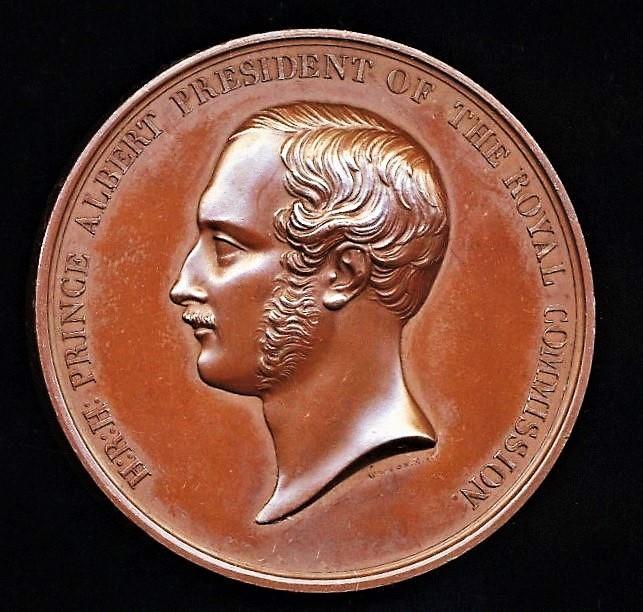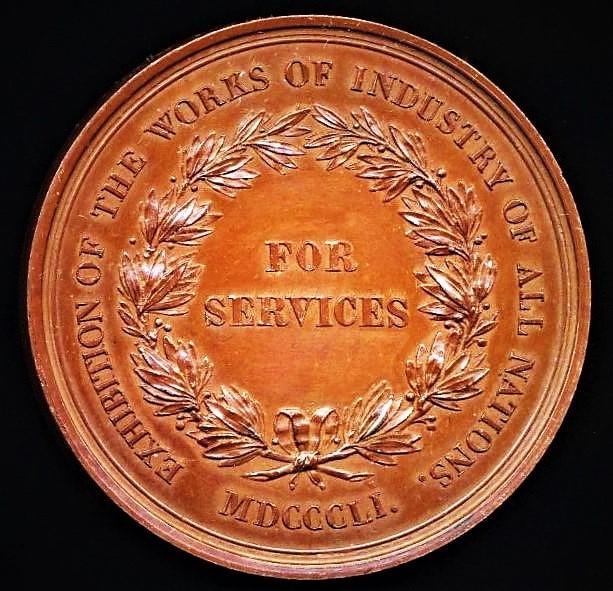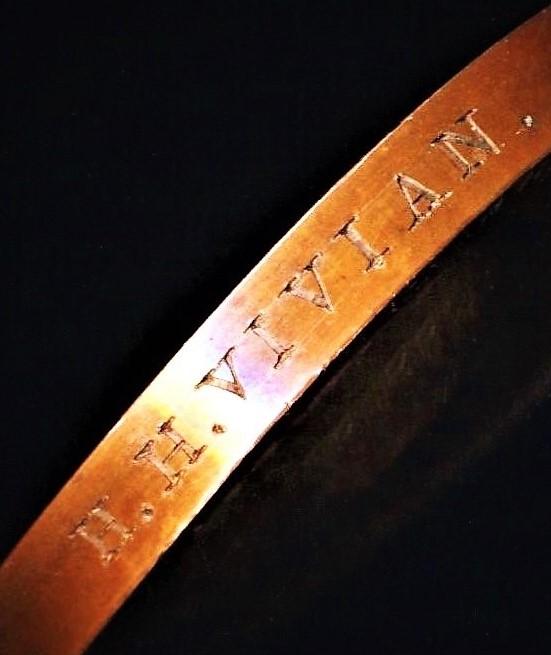Great Exhibition 1851 'For Services' Medal. Officially named (H. H. Vivian) later Lord Swansea
Important: The medal awarded to Henry Hussey Vivian (1821 - 1894), Lord Swansea, former Lieutenant-Colonel of the 4th Glamorgan Volunteers
He served as a Member of Parliament for Truro 1852–7, Glamorganshire 1857–85 and Swansea District 1885–93. In 1889 he became the first chairman of the Glamorgan County Council. He was also a Justice of the Peace, Deputy Lieutenant for Glamorgan
Military service: Lord Swansea for many years was first Lieutenant-Colonel of the 4th Glamorgan Rifle Volunteers.
He was created a Baronet on 13 May 1882 and Baron Swansea on 9 June, 1893
The national Biography of Wales includes the below following biography on Lord Swansea:
Quote,
VIVIAN, Sir HENRY HUSSEY, first Baron Swansea (1821–1894), born at Singleton on 6 July 1821, was eldest son of John Henry Vivian of Singleton, Glamorganshire, a merchant engaged in copper smelting, who was M.P. for Swansea from 1832 till his death in 1855, by his wife Sarah, eldest daughter of Arthur Jones of the Priory, Reigate. Sir Richard Hussey Vivian, first baron Vivian q. v., was his uncle. He was elected to Eton in 1835 (Stapylton, Eton Lists), and in 1838 went to the continent, where he studied metallurgy for two years in Germany and France. In 1840 he entered Trinity College, Cambridge. In 1842 he undertook the management of the Liverpool branch of the firm of Vivian & Sons, of which he became a partner. In 1845 he removed to Swansea, where he managed the Hafod smelting works under his father. Upon his father's death in 1855 he took control of the works, and greatly developed them. When he succeeded to the management the main work was the smelting of copper. Vivian applied the stores of metallurgical knowledge he had acquired on the continent, and obtained numerous by-products from the mineral. Under his influence Swansea became ‘the metallurgical centre of the world.’ Soon after becoming a partner he introduced the manufacture of spelter or zinc, for which he took out a patent (No. 9591) on 14 Jan. 1843. In 1850 he introduced the extraction of gold by Plattner's process, and in 1855 commenced the production of nickel and cobalt, in connection with which he had taken out a patent (No. 13800) on 4 Nov. 1851. On 23 June 1856 he obtained a patent (No. 1473) for extracting gold and silver from ores employed in the manufacture of copper, and on 16 April 1869 another (No. 962) for smelting copper. In 1864 he began to obtain sulphuric acid from copper smoke, and in 1871 erected works at White Rock, near Swansea, to treat poor silver-lead ores. On 12 Feb. 1883 the business was registered as a limited liability company under the style of H. H. Vivian & Company, Limited. Vivian was chairman, and to the last almost solely controlled the enormous business. The company was reconstructed in 1897. A man of remarkable energy and business capacity, Vivian threw himself with ardour into the administration of the business of the county. He was the first chairman of the Glamorgan county council from 1889 till his death. He long occupied a commanding position in South Wales. After the coal strike in South Wales in 1889, he originated the celebrated sliding scale that has since formed an important basis for settling disputes between masters and men. He played an active part in extending the harbour resources of Swansea, and he was one of the chief promoters of the Rhondda and Swansea Bay railway, by means of which coal was brought direct from the great Rhondda Valley and shipped at Swansea.
As a liberal he long sat in parliament. He was M.P. for Truro from 1852 to 1857, in which year he was elected for Glamorganshire, and he was again returned at every successive election until 1885. He was raised to the dignity of a baronet on 13 May 1882, on Gladstone's recommendation. In consequence of the changes made by the Redistribution of Seats Act of 1885, he was chosen the member for Swansea district without opposition in November of that year. He was again elected in 1886 and 1892, but on 9 June 1893 was elevated to the peerage as Baron Swansea. Although a staunch member of the church of England, Swansea throughout his career voted in favour of disestablishment in Wales. A devoted admirer of Gladstone's policy, he followed his leader with unquestioning fidelity, and sided with him in favour of home rule. Throughout his long parliamentary career he was a frequent speaker in the House of Commons.
Swansea was a fellow of the Geological Society, and was author of ‘Notes of a Tour in America,’ 1878. He died suddenly at his seat at Singleton on 28 Nov. 1894, and was buried on 3 Dec. in Sketty churchyard. His statue was erected at Swansea in 1886.
Swansea was married three times: first, on 15 April 1847, to Jessie Dalrymple, daughter of Ambrose Goddard, M.P., of The Lawn, Swindon, Wiltshire. She died on 28 Feb. following, leaving one son, Ernest Ambrose, his successor in the title. He married, secondly, on 14 July 1853, Caroline Elizabeth, daughter of Sir Montague John Cholmeley, second bart., M.P., which lady died on 25 Jan. 1868, leaving one son. On 10 Nov. 1870 he married, thirdly, Averil, daughter of Captain Richard Beaumont, R.N., and granddaughter of Godfrey, third lord Macdonald, by whom he had two sons and four daughters.
Unquote.
Lord Swansea was the maternal Grandfather of Brigadier-General Archibald Vivian Campbell Douglas who - as a Captain in Scots Guards - married Maurice de Bunsens youngest daughter Elizabeth Cicely de Bunsen in 1927
This medal with family associations to other items in the website listings, see the various Red Cross and Womens Land Army medals and insignia to the de Bunsen sisters, Elizabeth Cicely Douglas (nee de Bunsen) & Rosalind de Bunsen, the daughters of the highly distinguished Great War era British Diplomat Sir Maurice William Ernest de Bunsen, 1st Baronet, GCMG, GCVO, CB, PC (8 January 1852 – 21 February 1932)'
Condition: Better than GVF
Code: 21402






